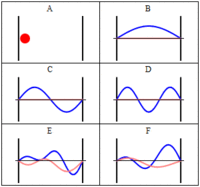Particle in a box

Imagine a box, like your toy chest at home, but instead of toys in it, there's a particle, like a little ball or a molecule.
The box has walls, just like your room at home, but these walls are imaginary - they don't have any physical substance.
The particle inside the box bounces back and forth between the walls because it can't escape due to the imaginary walls.
Now, imagine that the box is so small that the particle can only move in one direction - left or right.
This means that the particle is trapped in the box, and it can't move up or down, forwards or backwards.
The only way it can move is left or right, bouncing back and forth between the imaginary walls of the box.
This is called a "particle in a box" because the particle is trapped inside an imaginary box that limits its movements to a certain direction.
Scientists study particles in boxes to learn more about their behavior and properties. It can help them understand how particles behave on a microscopic level, which is important for many branches of science, including chemistry and physics.
The box has walls, just like your room at home, but these walls are imaginary - they don't have any physical substance.
The particle inside the box bounces back and forth between the walls because it can't escape due to the imaginary walls.
Now, imagine that the box is so small that the particle can only move in one direction - left or right.
This means that the particle is trapped in the box, and it can't move up or down, forwards or backwards.
The only way it can move is left or right, bouncing back and forth between the imaginary walls of the box.
This is called a "particle in a box" because the particle is trapped inside an imaginary box that limits its movements to a certain direction.
Scientists study particles in boxes to learn more about their behavior and properties. It can help them understand how particles behave on a microscopic level, which is important for many branches of science, including chemistry and physics.
Related topics others have asked about:
